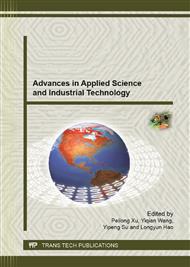[1]
Sarfati MR, DiLorenzo DJ, Kraiss LW, et al. Severe coagulopathy following intraoperative use of topical thrombin [J] Ann VascSurg, 2004, 18(3): 349-351.
DOI: 10.1007/s10016-004-0028-3
Google Scholar
[2]
Ruolan Gu, Wenzhong Sun, Hong Zhou, et al. The performance of a fly-larva shell-derived chitosan sponge as an absorbable surgical hemostatic agent. Biomaterials, 2010, 31(6): 1270-1277.
DOI: 10.1016/j.biomaterials.2009.10.023
Google Scholar
[3]
Khor E, Lim LY, Implantable applications of chitin and chitosan, Biomaterials, 2003, 24 2339–2349.
DOI: 10.1016/s0142-9612(03)00026-7
Google Scholar
[4]
Sohn VY, Eckert MJ, Martin MJ, Arthurs ZM, Perry JR, Beekley A, et al. Efficacy of three topical hemostatic agents applied by medics in a lethal groin injury model. J Surg Res 2009, 154: 258–61.
DOI: 10.1016/j.jss.2008.07.040
Google Scholar
[6]
Wu WP, Peng CH, Han BS, Zhang ZP, Chen H, Yang ZP. Hemostatic effect of O-carboxymethyl chitosan powder on the trauma surface in rats. Surg J. Concepts Prac. 2010, 15: 240–244.
Google Scholar
[7]
Srivastava R.; Chatterji U, Kundu P. P, Sarkar K. Evaluation of chitosan and their self-assembled nanoparticles with pDNA for the application in gene therapy. Journal of Applied Polymer Science, 2011, 121(4): 2239-2249.
DOI: 10.1002/app.33832
Google Scholar
[8]
Braun JL, Kadla JF. A relatively simple method for calculating Mark-Houwink parameters using basic definitions. Journal of Applied Polymer Science 2009, 14 (5): 3303-3309.
DOI: 10.1002/app.30710
Google Scholar
[9]
Sun Yushan, Liu Xin, Wang Yue, et al. Research on Haemostatic Function of Biological Medical Textiles. Technical textiles, 2000, 18 (123): 28-32.
Google Scholar
[10]
Hoffman A S. Synthesis and application of thermally reversible heterogels for drug delivery. Journal of controlled release. 1990, 13: 21-31.
DOI: 10.1016/0168-3659(90)90071-z
Google Scholar
[11]
Ong SY, Wu J, Moochhala SM, Tan MH, Lu J. Development of a chitosan-based wound dressing with improved hemostatic and antimicrobial properties. Biomaterials 2008; 29: 4323–4332.
DOI: 10.1016/j.biomaterials.2008.07.034
Google Scholar
[12]
Qin Wang, Yangchao Luo, Zi Teng. Development of zein nanoparticles coated with carboxymethyl chitosan for encapsulation and controlled release of vitamin D3. Journal of Agricultural and Food Chemistry 2012, 60(3): 836-843.
DOI: 10.1021/jf204194z
Google Scholar
[13]
Lim JY, Taylor AF, Li Z, et al. Integrin expression and osteopontin regulation in human fetal osteoblastic cellsmediated by substratum surface characteristics J. Tissue Eng 2005,11 ( 1- 2) : 19- 29.
DOI: 10.1089/ten.2005.11.19
Google Scholar
[14]
Dawei Fu, Baoqin Han, Wen Dong, et al. Effects of carboxymethyl chitosan on the blood system of rats. Biochemical and Biophysical Research Communications 2011, 408: 110-114.
DOI: 10.1016/j.bbrc.2011.03.130
Google Scholar


